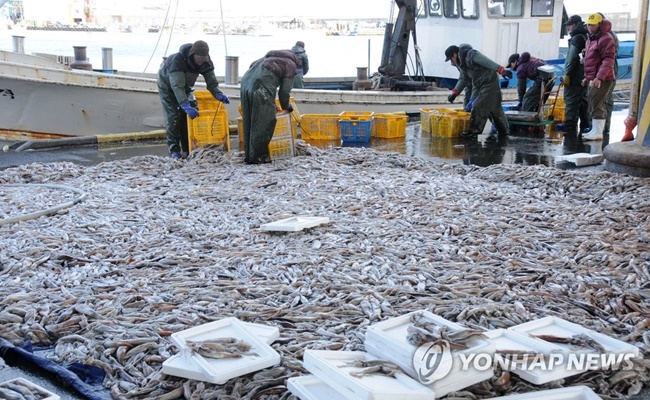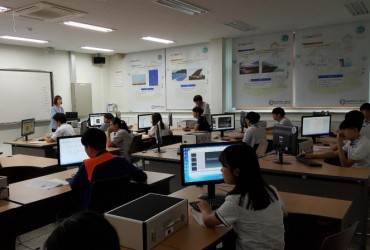
Data from Statistics Korea also shows that squid prices have gone up by more than 51 percent over the last year. (Image: Yonhap)
SEOUL, April 2 (Korea Bizwire) – Deep fried squid has almost disappeared at street food vendors across South Korea, as prices of the beloved seafood continue to surge.
Kim, who orders street food takeaway from time to time, was left shocked after learning that deep fried squid was taken off the menu at his favorite snack restaurant, commonly known in Korea as ‘bunsik’, which refers to inexpensive Korean dishes.
Squid is even being taken off the menu at some seafood restaurants, as retail prices of the seafood have surpassed 4,000 won for the first time last year since 2007, according to the Korea Agro-Fisheries & Food Trade Corporation.
Data from Statistics Korea also shows that squid prices have gone up by more than 51 percent over the last year.
So why is squid so much more expensive than before in South Korea? Catches have dropped significantly in recent years.
During the first half of 2016, a total of 28,300 tons of squids were caught by South Korean fishermen. One year on, the figure dropped by nearly 30 percent, standing at around 20,000 tons.
While the significant decrease in the squid catch means fewer squid snacks for many, it means much more for those in the fishing industry, particularly in Gangwon Province and North Gyeongsang Province, where squids are the lifeblood of the economy for many.
The impact of rising squid prices has also spilled over into the fish processing industry, as a number of squid processing companies in Gangneung have gone out of business, leaving nearly 1,000 people unemployed.

Squid is even being taken off the menu at some seafood restaurants, as retail prices of the seafood have surpassed 4,000 won for the first time last year since 2007, according to the Korea Agro-Fisheries & Food Trade Corporation. (Image: Yonhap)
While environmental changes that led to a rise in sea temperatures have affected the squid catch, similar to how the popular pollack has disappeared from Korean waters, concerns are growing over illegal Chinese fishing boats, which are sweeping waters off the North Korean coasts of squid, wiping the seafood off the South Korean map.
Statistics from the Korean Society of Fisheries and Aquatic Science back the claim, as squid catches in South Korea and Japan have dropped significantly since 2004, when Chinese fishing vessels began operations in North Korean waters.
Between 2003 and 2016, the squid catch in South Korea dropped by 48 percent, from 233,000 tons to 122,000 tons, while the figure plunged by 73 percent to 68,000 tons in Japan.
In the meantime, China’s squid catch rose by 52 percent, reaching 389,000 tons in 2016.
The growing gap between the Asian countries has prompted experts to call for cooperation, including more joint efforts to crack down on illegal fishing.

Statistics from the Korean Society of Fisheries and Aquatic Science back the claim, as squid catches in South Korea and Japan have dropped significantly since 2004, when Chinese fishing vessels began operations in North Korean waters. (Image: Yonhap)
High distribution costs
High distribution costs are one of the major factors behind the rising costs of squid, according to government data.
In a 2017 report released by the Ministry of Oceans and Fisheries (MOF), distribution expenses were responsible for over 50 percent of the retail prices of mackerel, squid, cutlassfish, and pollack on average.
For every 1,000 won generated by selling fish, distribution costs accounted for 518 won on average.
Against this backdrop, the MOF announced plans last month to build five additional Fisheries Products Processing & Marketing Centers (FPC) in an attempt to slash distribution expenses.

High distribution costs are one of the major factors behind the rising costs of squid, according to government data. (Image: Yonhap)
“With the expansion of FPCs, we hope to encourage value-adding activities in the production stage, including packaging and processing cuts of fish. As we learned through the investigation that the seafood market distribution infrastructure is in poor condition, we will focus on expanding infrastructure,” said Jung Do-hyun, a senior official overseeing market distribution policy at the fisheries ministry.
Ashley Song (ashley@koreabizwire.com)






